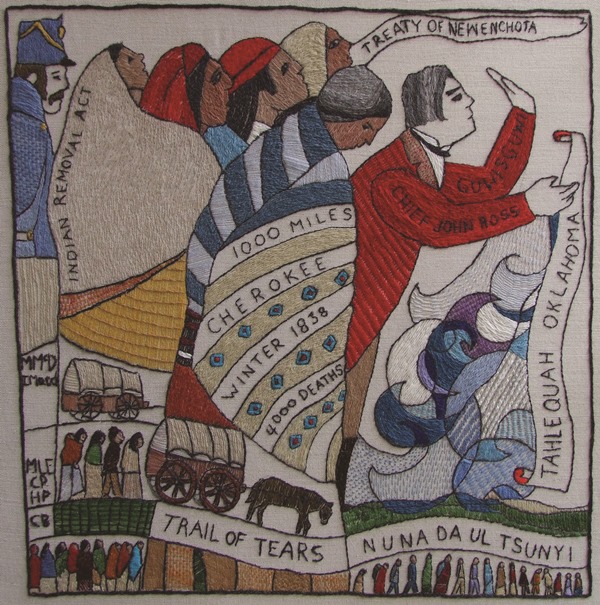
Stitchers (Mobile, Alabama): Carol Brooks, Mary McDonald, Margaret Lynn Ellis, Cynthia Parham, Hank Parham, JoAnne Henderson, Irene Macdonald, Kenneth Macdonald
The US government of the early nineteenth century was eager to expand its territories, and as part of this process applied diplomatic and military pressure to the native peoples. The Cherokee were just one of the tribes forcibly displaced after the Indian Removal Act. In 1838, under the leadership of Chief John Ross who had attempted to resist the pressure, many of the Cherokee undertook an arduous thousand mile trek to new lands in Oklahoma. Around 4,000 died along the way. The Cherokee call the exodus Nu na da ul tsun yi (the Place Where They Cried).
 US14 Slighe nan Deòir
US14 Slighe nan Deòir
Tràth san naoidheamh linn deug bha riaghaltas nan Stàitean Aonaichte airson an sgìrean a leudachadh a-mach, agus mar phàirt den phròiseas seo chuir iad cuideam dioplòmasach agus armailteach air na daoine dùthchasach. Is e an Cherokee aon de na treubhan a chaidh a chur às àite le làmhachas-làidir, an dèidh Achd Imrich nan Ìnnseanach. Ann an 1838, fo cheannardas a’ Chinn-cinnidh Iain Rosach a bha air feuchainn ri dhol an aghaidh a’ chuideim seo, ghabh mòran den Cherokee os làimh turas cruaidh de mhìle mìle gu fearann ùr ann an Oklahoma. Bhàsaich mu 4,000 neach air an t-slighe. Thug an Cherokee Nu na da ul tsun yi (an t-Àite san robh an Caoineadh) air an às-imrich seo.
